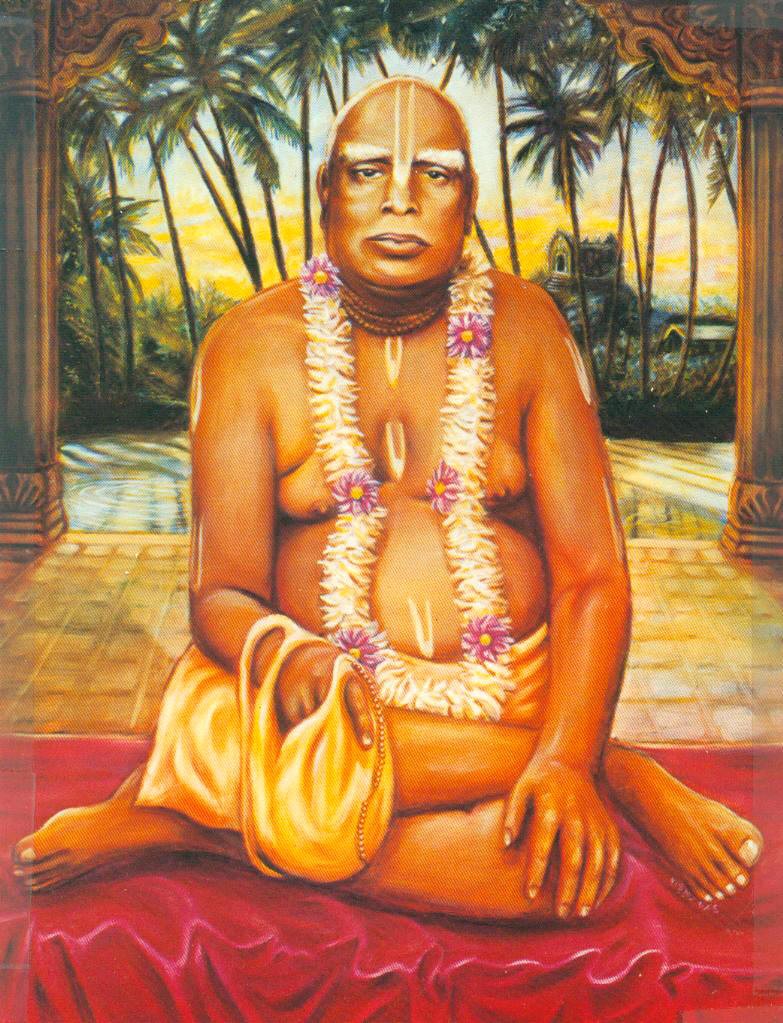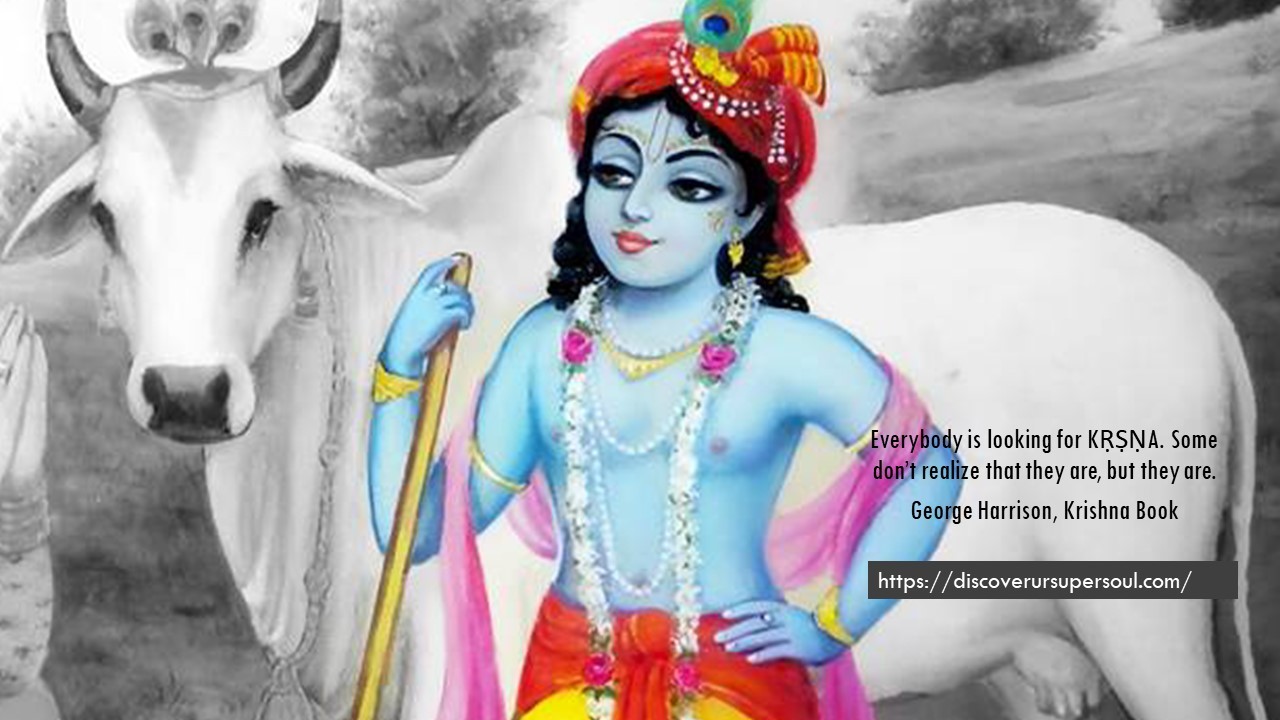
If we want to practice Krishna Consciousness sincerely then we should study the life of Srila Bhaktivinoda Thakura. He is a prominent Vaisnava acharya and has played an extraordinary role in reviving Gaudiya Vaisnavism. Not just that, he also taught us by his personal example how to be an ideal Vaisnava.
Today if we go to any part of the world then there could be a possibility that we will see men and women donning Vedic dress, having tilak on forehead, chanting the names of Krishna. It became possible because of Bhaktivinoda Thakura. To know how this became possible, we will have to reflect on the life of Srila Bhaktivinoda Thakura.
In Srimad Bhagavad Gita 3.21, Lord Krishna says that the nature of the common man is to follow the footsteps of someone who has incredible credentials and achievements in the world. It is true that Krishna spoke Gita to Arjuna because Arjuna was a great devotee. But it is also true that Arjuna had a heroic personality, he was an undefeatable warrior. People listen to such people carefully and follow their advice sincerely. So, Krishna chose Arjuna to deliver the transcendental teachings of Gita.
Krishna came as Sri Chaitanya Mahaprabhu 500 years back to teach everyone how to use the human life to attain freedom from all sufferings. And mostly importantly how to return back to the eternal spiritual world which is free of all sufferings.
Chaitanya Mahaprabhu’s movement needed a leader
After Sri Chaitanya Mahaprabhu disappeared, his mission was carried by six Goswamis of Vrindavan and later by prominent acharyas like Narottama Das Thakur, Srinivas Acharya, Shyamananda Pandit. But gradually as the dark age of Kaliyuga began spreading its fangs, Mahaprabhu’s mission started losing its sheen. Most of the people got engrossed in materialistic life and forgot the teachings of Chaitanya. Only few genuine Vaisnavas remained.
Some who claimed to follow Mahaprabhu’s teachings were deviants. They were misguiding and cheating the general people. So, genuine spiritual seekers and intellectuals started keeping distance from such deviants. The deviants brought disrepute to Gaudiya Vaisnavas. So, if Chaitanya Mahaprabhu’s movement had to survive then it needed a leader of exceptionally quality.
During this time came Srila Bhaktivinoda Thakura who is also known as Sri Kedaranatha Datta. He appeared on 2nd September 1838 in Biranagara (Ulagrama), West Bengal, India.
A devotee full of divine qualities, he played a significant role in re-establishing the authentic teachings and practices of Sri Chaitanya Mahaprabhu. He put in lots of effort to revive Chaitanya’s movement and reinstate it in its original glory.
Bhaktivinoda Thakura laid the foundation of worldwide Krishna Conscious Movement
It won’t be wrong to say that Srila Bhaktivinoda Thakura laid the foundation of present-day Krishna conscious movement which has spread all over the world.
He was an erudite scholar and knew many languages – Sanskrit, Bengali, Oriya, English, Latin, Urdu, Persian. A prolific writer, he wrote around 100 books and many devotional songs. He was also a great orator.
By profession, he was a judicial magistrate. Bhaktivinoda Thakura carried out his occupational duty diligently and he was very expert in his work and his colleagues and superiors praised him for his efficiency.
He was married to Srimati Bhagavati Devi, who remained his lifelong companion. He had 13 children. Materially he was highly qualified and led an exceptional grihasta life. He was a role model for all.
So, when he began propagating the original teachings of Sri Chaitanya Mahaprabhu then people started listening to him. Gradually scores of people including the Bengali Bhadralok community started understanding and appreciating the philosophy of Gaudiya Vaisnavism.
Because of his monumental efforts, Sri Chaitanya Mahaprabhu’s teachings and sankirtana movement revived. In fact, it won’t be an exaggeration to say that Lord Chaitanya personally sent him to re-establish his movement.
Although his contributions in reviving and spreading Gaudiya Vaisnavism is immense but here we discuss his three major contributions.
1. Discovered the birthplace of Sri Chaitanya Mahaprabhu
It is because of Bhaktivinoda Thakura that today the world knows the birthplace of Lord Chaitanya. As the people had forgotten the teachings of Lord Chaitanya, they had also forgotten where the Lord had appeared. Lord Chaitanya inspired Bhaktivinoda Thakura to discover his birthplace.
It was 1887, when Thakura Bhaktivinoda, was planning to go to Vrindavana and spend rest of his life at the bank of Yamuna chanting the names of Krishna. While he was contemplating on this, one night Lord Chaitanya appeared in his dream and said, “Going to Vrindavan is great and you will surely go there. But before going to Vraja, do some service in Navadwip too.”
It was Chaitanya’s desire and instruction. Bhaktivinoda Thakura immediately began making plans to move to Navadvipa. He requested to be transferred to Krishnanagar which is near to Navadvipa. After lots of efforts, he was finally successful in moving to Krishnanagar as Deputy Magistrate. From Krishnanagara he would regularly go to Navadvipa to search for the birthplace of Lord Chaitanya.
A divine vision
Once he was chanting on the roof of Rani Dharmashala in Navadvipa in the night. When he looked towards the north, he saw something strange. There was a big, beautiful Tala tree. Near the tree was a small building which was fully effulgent. Within his heart Bhaktivinoda Thakura understood that it’s not an ordinary place, it could be the birthplace of Lord Chaitanya. Before making a public announcement, he wanted to do thorough research.
He began studying Chaitanya Bhagavata and Navadvipa Dhama parikrama of Narahari Sarakara Thakura. He also spoke to many elderly people of Navadvipa about the place and studied old maps of Navadvipa. After extensive research and consultation, he was almost sure that this place is the birthplace of Lord Chaitanya. For final confirmation, he requested Jagannatha Dasa Babaji Maharaj to come to the place and give his verdict.
This indeed is the birthplace of Lord Chaitanya
Jagannatha Dasa Babaji Maharaj was a great devotee of Lord Chaitanya, he was the leader of Gaudiya Vaisnava community. He was very old and so he was carried in a basket to that divine place. As soon as he came to that spot, he literally jumped in the air out of spiritual ecstasy and said, “This is the place where Lord Chaitanya, the merciful Lord appeared.”
The news spread far and wide that the birthplace of Lord Chaitanya has been discovered.
Thousands of devotees thronged to that holy place to get the mercy of the Lord. A grand Vaisnava festival was arranged, and everyone praised Bhaktivinoda Thakura for this extraordinary work.
Srila Bhaktivinoda Thakura had predicted that a time will come when the glory of Sri Chaitanya Mahaprabhu will spread far and wide and people from all over the world will throng to Mayapur chanting the names of Gauranaga – Jai Sachinandana Goura Hari.
Today we see that thousands of people from all over the world come to Mayapur and visit Yogapita, the place where Lord Chaitanya appeared.
2. Wrote several books and articles to re-establish Gaudiya Vaisnavism
In spite of being a grihasta and having a day job he wrote extensively. In his entire life he came up with around 100 books and wrote many devotional songs.
Some of his prominent books include Sri Caitanya-sikshamrita, Vaishnava-siddhanta-mala, Prema-pradipa, Manah-shiksha, etc. He published Amrta-pravaha Bhasya which is his Bengali commentary on Caitanya-caritamrita.
Understanding the necessity of publishing Vaisnava literature, he established a printing press in Kolkata at Bhakti-bhavana and called it as ‘Sri Caitanya Yantra.’ From ‘Sri Caitanya Yantra’ came out many books which propagated the teachings of Sri Chaitanya Mahaprabhu.
He introduced Chaitanya era or Caitanyabda. Based on this Gaudiya Vaisnavas calculate the day of the year beginning from the day of the appearance of Sri Chaitanya Mahaprabhu.
He also made Caitanya Panjika which is a Vaisnva almanac popular.
He started the publication of Sajjanatosani, a Vaishnava journal from 1881. This journal preached the message of Lord Chaitanya and was distributed all over Bengal. He wrote an article on the life of Sri Chaitanya Mahaprabhu in English periodical, Hindu Herald. It brought great respectability and acceptability to the Vaisnava community.
Chaitanya’s teachings reach west for the first time
Srila Bhaktivinoda Thakura introduced Sri Chaitanya Mahaprabhu to the western world. In the year, 1896, he wrote a book in English entitled, Chaitanya Mahaprabhu, His life and Precepts, and sent it to the west. This was the first time in the history of Gaudiya Vaishnavism that the teachings of Lord Chaitanya written in English reached west.
It is also noteworthy that Srila Prabhupada, the founder acharya of Iskcon, who later preached extensively in the west was born in 1896. This book was sent to many prominent institutes like McGill College of Canada and Royal Asiatic Society of London. In 1967, a disciple of Srila Prabhupada who was a graduate student found this book in the McGill University library.
He also wrote many devotional songs glorifying the Lord and the sankirtan. These songs are today sung by thousands of devotees all over the world.
3. Inspired thousands to chant and follow Lord Chaitanya’s teachings
He preached far and wide. Following the footsteps of Lord Nityananda, he established Nama Hatta which means “marketplace of holy name.” The purpose of Nama Hatta was to spread the glories of holy names and inspire people to chant the names of Krishna and take shelter of the teachings of Lord Chaitanya.
Whenever he got opportunity, he travelled to different parts of Bengal and gave lectures on Bhagavatam and Chaitanya Charitamrita.
When he was posted in Jagannath Puri, he established Bhagavata – samsat society. In this society devotees came to discuss on the topics of Lord Krishna in the famous Jagannatha – vallabha garden.
He had discovered Yogapitha, the birthplace of Lord Chaitanya in Mayapur. Now, at Yogapitha, he decided to install the deities of Gaura and Vishnu Priya (eternal consort of Lord Chaitanya). On the day of the installation of the deities, thousands of Vaisnavas assembled.
There was a big festival and sankirtana. In order to build a magnificent temple at Yogapitha, Mayapur, he begged from door to door urging people of Bengal to participate in the building of grand temple.
Srila Bhaktivinoda Thakura is not an ordinary personality. He came to revive the movement of Sri Chaitanya Mahaprabhu and also teach you and me how to sincerely follow the teachings of Lord Chaitanya.
From the life of Srila Bhaktivinoda Thakura, we learn following important lessons.
Seven important lessons to learn from the life of Srila Bhaktivinoda Thakura
1. Always be engaged productively
He taught us how to utilize each and every moment of life productively. When we study his life, we find that he was either chanting the names of Krishna or reading spiritual literatures or writing articles and books or preaching Krishna Conscious philosophy or was busy in his office work.
2. Manage Time Effectively
His daily schedule was quite austere, but he followed it strictly.
- 8-10 P.M. Rest
- 10-4 A.M. Write
- 4-4:30 A.M. Rest
- 4:30-7 A.M. Chant Japa
- 7-7:30 Correspondence
- 7:30-9:30 Study sastras
- 9:30-10 Bath, prasadam (half-liter milk, fruit, 2 chapatis)
- 10-1 P.M. Court Duties
- 1-2 P.M. Refresh at home
- 2-5 P.M Court Duties
He kept a pocket watch with him to make sure he does everything on time. Although we may not be able to exactly follow his schedule but from this, we learn the importance of managing time effectively.
We should plan our day in a way that we utilize our time in spiritual activities and prescribed duties. There should not be any idle time or time for sense gratification.
3. Do not waste time in movies and TV shows
He had no interest in theatres. Once Girisha Chandra Ghosa invited Bhaktivinoda Thakura on the opening day of his play Chaitanya Lila but Thakura politely refused. He was of the opinion that theatres distract people from their spiritual goals.
Most of the people in Kaliyuga are anyway not much interested in spiritual activities and if they get addicted to theatres then there will be no hope left. Also, theatres promote carnal pleasure, and many times normalize illicit relation between men and women.
None of us can disagree with this. Today movie, TV serials have replaced theatres. And what we see there is vulgarity and violence. So, if we want to seriously pursue devotion to Krishna then we have to seriously think about our addiction for movies and TV shows.
4. Work sincerely by keeping Krishna in centre
He never considered his work as a burden. He did his job efficiently. As deputy magistrate he had to resolve many disputes which came in the court. He resolved the cases promptly and made sure that justice is done to the aggrieved. It is a very important lesson for us, grihastas.
Frro the life of Srila Bhaktivinoda Thakura, we learn that we should never consider our work as troublesome and never have escapist mentality. We should do our prescribed duties diligently by keeping Krishna in the centre. Krishna also said to Arjuna to fight the Kurukshetra war and not run away from the battlefield. But while doing his duty of fighting, Krishna advised Arjuna to always think about him.
5. Be an ideal grihasta
He had 13 children and a devoted wife. He led an exemplary grihasta life and made sure that his wife and his children are always engaged in the service of Krishna. Once he said, “When I enter my house, I feel that I have entered into Vaikuntha because I see everyone in the house absorbed in chanting the names of Krishna.”
His son, Srila Bhaktisiddhanta Saraswati Thakura, later became one of the great Vaisnava acharyas and established Gaudiya Mathas all over India. Gaudiya Mathas played an important role in spreading Gaudiya Vaisnavism in India and present day Bangladesh.
As grihasta devotees, it is our responsibility to create an atmosphere at home so that our family members get inspired to practice devotion to Krishna. Also, wife (or husband) and children are not a burden in our Krishna Conscious journey.
6. Actively participate in preaching
From the life of Srila Bhaktivinoda Thakura, we learn that grihasta devotees should also play an active role in preaching the message of Krishna and Chaitanya. They should not be too attached to wife and children like an ordinary householder.
They should shun material attachment and laziness and work hard to spread Krishna Consciousness.
7. His divine qualities which devotees should aspire for
He was very charitable. No one returned from his home empty handed. He was equal to all and never discriminated people based on caste, creed, religion, gender and financial status. Just like Lord Nityananda, he showered his mercy upon all. He considered every living entity as God’s children and never kept grudge or bore ill feelings towards anyone.
Since he was materially successful so there were people who were jealous of him and tried to harm him in different ways but later those people seeing Bhaktivinoda Thakura’s saintly qualities felt ashamed of themselves.
In Bhagavad Gita 17.15, Lord Krishna says, “Austerity of speech consists in speaking words that are truthful, pleasing, beneficial, and not agitating to others, and also in regularly reciting Vedic literature.” Thakura Bhaktivinoda exemplified this. He lived by this principle.
He was always truthful and never spoke a word which would agitate others and he would constantly chant the Hare Krishna Mahamantra and sang glories of Krishna and Chaitanya.
Conclusion
His contributions are many and cannot be described in words. He not just revived Gaudiya Vaishnavism but by his exemplary life, Srila Bhaktivinoda Thakura taught us the quality and characteristics of genuine Vaisnavas.
As a best well- wisher of all, he desperately wanted everyone to take shelter of Lord Chaitanya and attain complete perfection.
He would give clarion call to all to shun their laziness and begin practicing Krishna Consciousness without delaying it even for a moment. In one of his beautiful songs, Udilo Aruna Puraba Bhage, he tries to reawaken us, the conditioned souls.
“You have achieved such a rare human body, but you do not care for this gift. You remain not serving the darling of Yashoda and slowly fall through your last moments to death. With every rising and setting of the sun, a day passes and is lost. Then, why do you remain idle and not serve the Lord of the heart?”






